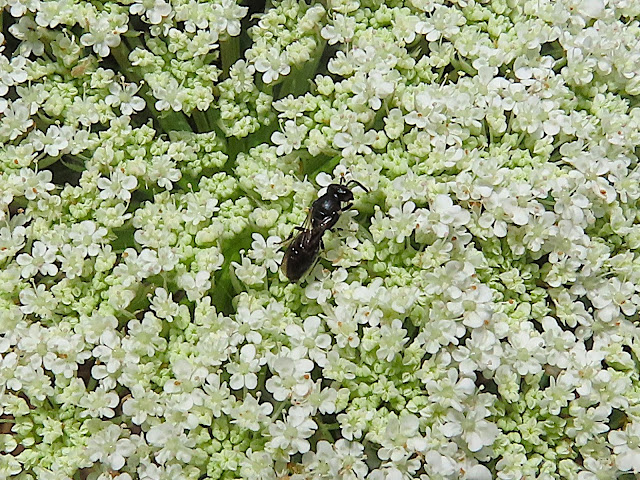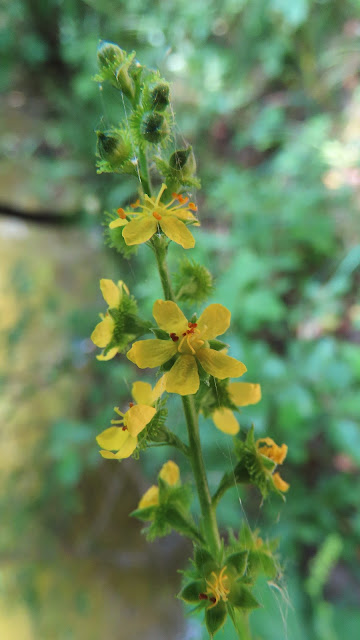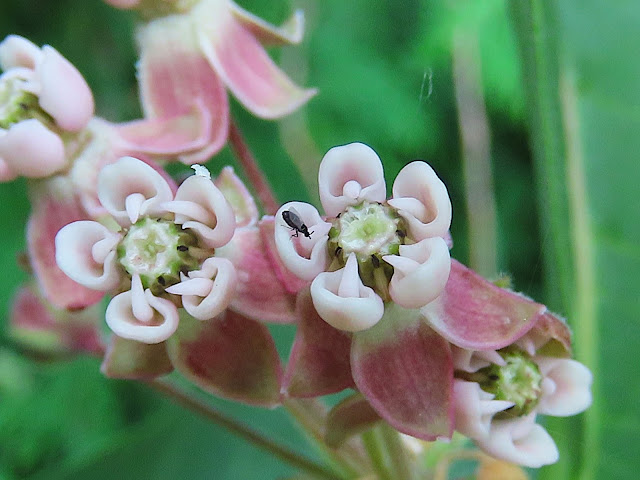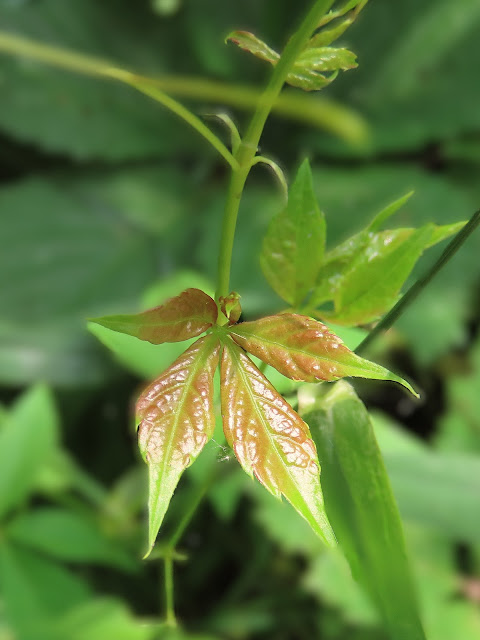08 July, 2025
Some of you may be shocked that this is my second account of our walks without a single picture of a bird. Generally, avian activity is quiet in July and August; many species are occupied with the serious business of raising young, and we tend to direct our attention to other taxa during this period.
North American Common Water Striders (Aquarius remiges) are an eternal source of fascination for Miriam and me.
Summer is the time to collect pollen and nectar while the sun shines and this Masked Bee (genus Hylaeus) was foraging on Wild Carrot (Daucus carotus)
This species is probably Lucilia sericata and is generally viewed as a common pest throughout the world. It is sometimes implicated in blowfly strike in sheep. Ironically it is also beneficial to humans for use in maggot therapy to treat serious infections.
Tall Hairy Agrimony (Agrimonia gryposepala) was easily found.
I strained to hear the refrain of bagpipes; alas there were none. Perhaps I should have worn a kilt!
A Margined Calligrapher (Toxomerus marginatus) shared its space with a member of the family of flies known derisively as Freeloader Flies (family Milichiidae), who are kleptoparasitic, attracted to prey caught in spider's webs.
More Tall Hairy Agrimony.
I have not been able to find out a great deal about this species of Long-legged Fly (genus Amblypsilopus), but it is spectacularly attractive.
Annual Fleabane (Erigeron annuus)
Here is an unusual closeup of Common Milkweed (Asclepias syrica) playing host to an unidentified insect.
Margined Calligrapher (Toxomerus marginatus) is one of our most common flower flies during the summer.
A male Streamside Bluet (Enallagma exsulans) was perched very dramatically, I thought, but I can assure you that it was not us he was trying to impress.
Here you see a large assemblage of Black Bean Aphids (Aphis fabae) being guarded by Eastern Black Carpenter Ants (Camponotus pennsylvanicus) who defend the aphids from predators in return for their honeydew.
Another Green Frog seemed quite indifferent to our presence.
This branch with its luxuriant growth speaks volumes about the recycling of energy and nutrients in the forest.
Fly Honeysuckle (Lonicera xylosteum)
Bluets were busily engaged in ensuring the next generation will have a good start in life.
Virginia Creeper (Parthenocissus quinquefolia)
I know that many people harbour an irrational fear of spiders, and telling you not to fear them probably does nothing to alleviate your dread, but Miriam is happily hanging out with a Running Crab Spider (genus Philodromus).
In a recent report you may recall seeing pictures of one of the hugest Common Snapping Turtles (Chelydra serpentina) we have ever seen. The individual shown below was at the other end of the scale, quite small as snappers go, probably no more than a year or two old.
A Bur Oak (Quercus macrocarpa) seedling was trying to establish itself, vying to capture sunlight penetrating through the canopy to the forest floor.
Tall Meadow-Rue (Thalictrum pubescens)
Many trees show signs of stress, no doubt brought on by uncertain rain and excessive heat; Sugar Maples (Acer saccharum) perhaps more than most.
An American Toad (Anaxyrus americanus) lingered in front of us for a moment or two as we neared the parking lot.


























































Wonderful sightings! It's always great to see the diverse life thriving around us.
ReplyDeleteI really like the common snapper and the anurans in this post - the photo of the American toad is so nice!
ReplyDelete...David, no detail goes unnoticed when you are out!
ReplyDeleteI am sure I miss a lot, Tom.
DeleteAbsolutely stunning, David. Glorious captures.
ReplyDeleteHari Om
ReplyDeleteNot shocked - there were plenty of wings on show, albeit not avian! The Hypericum triggers fond memories of my late father's garden in which sat a bush we planted there some fifty years back. Every summer it was abundant in yellow and attracted all varieties of bee and wasp to its nectar. Positively humming... I miss that bush... YAM xx
Enjoyed your pictures. Nature always has something to show us, no matter what size scale.
ReplyDeleteThere's always lots of interesting observations when you write a post about your latest walk in the country. No birds, but lots of other creatures and plants to learn about.
ReplyDeleteCirsium vulgare - there are no pleasant memories with it from childhood.
ReplyDeleteEven if you don't have pictures of birds David, all the flowers are a very good substitute! It's very dry here too, and I hope that some rain will come soon.
ReplyDeleteHugs and kisses, Marit
I inadvertently deleted a comment by Angie's Recipes. Sorry, Angie. You were asking about the host plant for the Common Red Soldier Beetles above. It is Wild Carrot, often known as Queen Anne's Lace (Daucus carota).
ReplyDeleteHello David.:)
ReplyDeleteThe male River Jewelwing, the female Widow Skimmers, and the male Streamside Bluet are very attractive, and the large concentration of damselflies was a fabulous sighting. I enjoyed seeing the plants, flies, and the frogs, toad, and Snapping Turtle.Your nature walk is greatly appreciated.
Hugs and kisses
Sonjia
Thank you, Sonjia.
DeleteThe insects are really amazing. I loved that fly. Toxomerus marginatus . The colors are really beautiful.
ReplyDeleteTurtles and toads, what more could one want?!
ReplyDeleteThe Streamside Bluet reminds me of a circus acrobat.
ReplyDeleteYour photography is wonderful! These creatures are a pleasure to see.
ReplyDeleteThank you, Danette. And thanks for stopping by my blog.
DeleteLove the photos showing details of the spiders and insects. The colours of the Calligrapher are amazing.
ReplyDeleteThose aphids and ants have an interesting relationship. You caught a great photo of them. And you've got to love the assortment of dragon and damselflies. July is all about insects, isn't it? Interesting I have seen hardly any birds at my feeders except some Downy woodpeckers. I guess they just assume hang out in the shady woods too. Thanks for sharing these photos and taking us along on a walkway with you.
ReplyDeleteYou see so much that most of us miss.
ReplyDeleteI worry about the oaks. They seem to be dying at an alarming rate around here. Nice to see that young one making a good start.
Your photos of the Bluets and other small creatures are as wonderful as your photos of birds. We do not see many birds at this time of the year along the Texas Gulf Coast either. We are happy to see what appears to be a couple of Red-Headed Woodpeckers. They used to be abundant here, but in recent years we have seen few of them.
ReplyDeleteHello, Prof! Mill Race is always such a lively outing; although there were no birds this time, the forest was just as generous, with flowers, curious insects, peaceful frogs, and even a little turtle.
ReplyDeleteLots of bisous to you and the friendly american toad 🐸
I'm intrigued by the Milkweed, amazing close up.
ReplyDeleteThe frog, spider, all the insects, frogs are all wonderful to see - thanks.
This is a beautiful series of photos, David.
ReplyDeletePhotos 22 and 23 are my favorites this time.
I wish you a wonderful weekend.
Best regards Irma
Diversity at its best!
ReplyDeleteCheers - Stewart M, Launceston, Tasmania
Do you ever stay home?
DeleteGreat pictures David ! Nature is full of diversity and beauty ! We have the duty to preserve what Hearth gave us for free !
ReplyDeleteHave a shinny weekend !
Hug
Anna
“We have the duty to preserve…….” When did we ever respect that obligation?
DeleteMooi gefotografeerd David.
ReplyDeleteMooi close in beeld gebracht de insecten.
Hier hou ik van.
Groetjes Tinie
My favorites in this grouping would be the Common Water Striders and the dragonflies, David.
ReplyDeleteTo watch water striders in action is a true study in fascination, Beatrice.
DeleteHow nice that you captured the iridescence on that fly's (?) wings. Virginia creeper is horribly invasive here and once it sets roots hard if not impossible to get rid of. We have a wolf spider living in our bathroom. When I first saw him he was missing a leg. I noticed yesterday that he had regrown it.
ReplyDeleteLove that toad and all these wonderful pictures.
ReplyDeleteI loved learning about the Greenbottle Flies being used in maggot therapy that's wild. The Bull Thistle reminding you of Scotland and making you wish for bagpipes and a kilt was pretty funny. It's also super interesting how the Eastern Black Carpenter Ants guard the Black Bean Aphids for their honeydew; nature is just full of unexpected relationships.
ReplyDeleteWonderful photos David. I don't fear spiders as I am sure you know! Good to see Scotland get a mention too! :-D
ReplyDeleteYour pictures are amazing, seriously. That little Green Frog is adorable, and it's wild to see the aphids being guarded by ants – teamwork. The tiny snapping turtle is super cute too. It's really inspiring to see how much detail you notice on your walks.
ReplyDeleteI just shared a new post. You are invited to read. Thank you. Have a nice weekend. www.melodyjacob.com
Magic to see the insects that you have over there. There are so many of them around at this time of the year, you just have to look carefully. Another reason for me to hate winter beside the cold, the insects disappear!! I might get a blog done soon. I fell in the garden earlier this week and broke a rib, so I am not quite as energetic as I normally am!! Take care both of you. Bisous mon ami, Diane
ReplyDeleteOh dear. I hope you recover soon, Diane. Gotta stop finishing that bottle of wine before doing the weeding! Bisous - David
DeleteMiddle of the day and stone cold sober. I would probably not have hurt myself so much if I had of had a relaxing drink !! 😊 Bisous.
DeleteOMGosh David. These photos are stunning. I do love the frog and the turtle. All the bugs and flies and spiders just wonderful!
ReplyDeleteBeautiful photos and the detail is exceptional. Virginia Creeper gives me a rash :( Hate the stuff.
ReplyDeleteI guess you could say that Virginia Creeper gives you the creeps!
DeleteNádherné fotografie z přírody.A detaily úžasné
ReplyDeleteVery enjoyable indeed! Your macros are stunning and all sights in between.
ReplyDeleteI loved St. Jacob's. Such natural beauty there and also the Mennonite community where back in the day we picked up a bolt of stunning handwoven cotton which I fashioned into all the bridesmaids' dress for my daughter's wedding. I always loved the Memories in their horse drawn wagons on the ir special lanes on the sides of the roads.
ReplyDeleteLovely shots David.
XO
WWW
Miriam is of Mennonite background and we see the scenes you describe every day. Just yesterday we bought corn and other produce from a local Mennonite farm. It is familiar, but we never take it for granted.
DeleteThanks for letting us tag along on your trek. Always enjoyable.
ReplyDeleteHave a grand weekend.
Hi David - what a lovely journey you've taken us on - I loved seeing all the pics and the flora and fauna - congratulations to Miriam for her photos ... talented two of you - cheers Hilary
ReplyDeleteHello David,
ReplyDeleteeven without the birds, a very interesting report.
Greetings, Frank
Zaintrygowała mnie ważka z białymi pasami na skrzydłach. Piękna jest, niezwykła.
ReplyDeleteOglądając Twoje zdjęcia z terenu, mam okazję obserwować różnice w roślinności i faunie. dziękuję!
I was fascinated by the fact that the Common St. John's Wort (Hypericum perforatum) was probably the only point of commonality between your photos and that which I might have been able to identify in my garden today.
ReplyDeleteVery enjoyable to see your sightings.
ReplyDeleteAll the best Jan
Estos son mis reportajes favoritos, me encantan y si habría un pajarito más. Gracias y abrazos.
ReplyDeleteThis morning when we hiked in a recently newly opened extension to one of our regional parks in the redwoods, we saw quite a lot of the water striders - they are indeed very fascinating. Unfortunately they were in deep shade (no surprise in the redwoods). I assume they make a great meal for birds. And like you said - in July and August there aren't too many bird sightings - this morning we only saw two Brown Creepers, a handful of Chestnut-backed Chickadees and we heard (but did not see) a Western Flycatcher. Like you showed us in your post, we turned to insects and plants, and I even "discovered" a new to me California native. If we keep our mind open, there is so much to discover. Big hugs - Carola
ReplyDeleteI saw the opening paragraph and thought “No way he has a post without birds!” But it was true, and a fine post it is.
ReplyDeleteI always enjoy your wonderful photos. That water spider is quite large. Great pic of the frog!!
ReplyDeleteDear David,
ReplyDeleteThat truly looks like a lovely summer walk – thank you for pointing me to this post! 🍃
I actually suspected in advance that you might want to show us The Mill Race during our visit (and of course the birds, who by then will have finished raising their young and will be eager to land on Austrian hands 😉🕊️).
Haha, I would have loved to see you in a kilt! 😄
As for spiders: until a few weeks ago I was quite relaxed about them (unlike Edi), since in Austria we only have one venomous spider species – a non-native one that occasionally makes headlines for sending children or elderly people to the hospital. 😬 Unfortunately, I may have fallen victim to this very spider myself: my right little toe suddenly showed clear signs of an allergic reaction – it became red and swollen, then turned purple, then part of my foot followed suit. The doctor was worried about a spreading infection and prescribed both cortisone and antibiotics (even though I usually try to avoid medications whenever I can 😕💊).
Luckily, things have improved – now the area just looks pink (and a bit wrinkly), so I believe the treatment worked. Despite all that, I’ll still rescue spiders that wander into our home. I’m sure they only bite when they feel threatened – maybe this one was hiding in my slipper or something like that… 🕷️ (I don't remember the bite itself, or rather, I didn't notice anything.) 👣
Sending warm greetings and wishing you a great start to August!
See you soon,
Traude
🍁🌿
By September the chickadees and nuthatches should be ready to accept food from humans again. I will issue strict instructions!
DeleteHello David, sorry for the late reaction but I was more outside than behind my computer.
ReplyDeleteNo birds this time on your outing but a lot of other wonderful observations of insects, frogs, toads etc. Great photos indeed and wonderful to join your walks via your blog.
Warm regards,
Roos